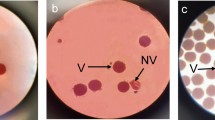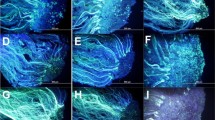Abstract
In our earlier study, pre-fertilization barrier was one of the main factors causing the failure of the wide hybridization between Chrysanthemum grandiflorum ‘Yuhuaxingchen’ and C. nankingense, and seriously restricted the utilization of the excellent chrysanthemum germplasm, C. nankingense. In order to overcome the pre-fertilization barrier and obtain some hybrids, we carried out wide hybridization between them again in this study, and tentatively adopted three pollination techniques including mentor pollen, delayed pollination, and gibberellic acid treatment. The average number of pollen grains germinating on stigma at 24 h after pollination and the percentage of embryo were investigated with a temporary mount method and the technique of fluorescence microscopy. It was found that, compared with the control, delayed pollination, gibberellic acid treatment, and mentor pollen significantly increased the average number of pollen grains germinating on each stigma at 24 h after pollination by approximately 152, 235, and 182%, respectively. In addition, all the three pollination techniques significantly increased the percentage of normal embryos at different periods after artificial pollination in comparison to the control. Furthermore, seed sets of the crosses using the three special pollination techniques were 1.1, 1.4, and 2.0%, respectively, whereas we did not obtained any seeds in the control. Taken together, these results suggest that delayed pollination, gibberellic acid treatment, and mentor pollen are three useful pollination techniques for overcoming pre-fertilization barriers and increasing seed set in the wide hybridization between C. grandiflorum ‘Yuhuaxingchen’ and C. nankingense, and they may be widely applied for increasing breeding efficiency in other chrysanthemum wide hybridization facing similar pre-fertilization barriers.


Similar content being viewed by others
References
Anderson NO (2007) Chrysanthemum. Dendranthema × grandiflora Tzvelv. In: Anderson NO (ed) Flower breeding and genetics. Springer, Netherlands, pp 389–437
Ascher PD, Peloquin SJ (1966) Effect of floral aging on the growth of compatible and incompatible pollen tubes in Lilium longiforum. Am J Bot 53:99–102
Chen RD, Zhang QX (2004) Primary study on the effect of GA on fruit setting rate in hybridization of Prunus mume. J Beijing For Univ 26:57–63
Chen Q, Mu D, Yi MF, Ming J, Liu C (2007) Effects of different pollination methods on bypassing pre-fertilization barriers in lily breeding. J China Agric Univ 12:35–40
Cheng X, Chen SM, Chen FD, Fang WM, Deng YM, She LF (2010) Interspecific hybrids between Dendranthema morifolium (Ramat.) Kitamura and D. nankingense (Nakai) Tzvel. achieved using ovary rescue and their cold tolerance characteristics. Euphytica 172:101–108
Dayton DF (1974) Overcoming self incompatibility in apple with killed compatible pollen. J Am Soc Hortic Sci 99:190–192
Deng YM, Teng NJ, Chen SM, Chen FD, Guan ZY, Song AP, Chang QS (2010a) Reproductive barriers in the intergeneric hybridization between Chrysanthemum grandiflorum (Ramat.) Kitam. and Ajania przewalskii Poljak. (Asteraceae). Euphytica 174:41–50
Deng YM, Chen SM, Lu AM, Chen FD, Guan ZY, Teng NJ (2010b) Production and characterisation of the intergeneric hybrids between Dendranthema morifolium and Artemisia vulgaris exhibiting enhanced resistance to chrysanthemum aphid (Macrosiphoniella sanbourni). Planta 231:693–703
Fukai S, Nagira T, Goi M (2000) Cross compatibility between chrysanthemum (Dendranthema grandiflorum) and Dendranthema species native to Japan. Acta Hortic 508:337–340
Howlett BJ, Knox RB, Paxton DJ, Heslop-Harrison J (1975) Pollen-wall proteins: physiochemical characterization and role in self-incompatibility in Cosmos bipinnatus. Proc R Soc Lond B 188:167–182
Hu SY (2005) Reproductive biology of angiosperms. Higher Education Press, Beijing
Jing SX (2000) Breeding science of horticulture. China Agriculture Press, Beijing
Kashyap R, Gupta SC (1989) The role of gibberellic acid in the pollen-pistil interaction in sporophytic self-incompatible systems. Plant Growth Regul 8:137–149
Knox RB, Willing RR, Pryor LD (1972a) Interspecific hybridization in poplars using recognition pollen. Silvae Genet 21:3–4
Knox RB, Willing RR, Ashford AE (1972b) Role of pollen wall proteins as recognition substances in interspecific hybridization in poplars. Nature 237:381–383
Li XL, Chen FD (2004) Advances of genetic improvement and germplasm resources for chrysanthemum. Chin Bull Bot 21:392–401
Li X, Wu HQ, Zhang SL (2008) Discrepancy of pollen germination and pollen tube growth at different mature degree of pistil in sweet cherry. J Fruit Sci 25:501–505
Ma YH, Sakata K, Masuda M (1999) Partial inhibition of pollen degradation by gibberellic acid in male sterile tomato mutants derived from cv. first (Lycopersicon esculentum Mill.). Scientific reports of the Faculty of Agriculture, Okayama University, vol 88, pp 57–63
Meng JL (1997) Genetics of plant reproduction. Science Press, Beijing
Nassar NMA, Carvalho CG, Vieira C (1996) Overcoming crossing barriers between cassava, Manihot esculenta Crantz and a wild relative, M. pohlii Warwa. Braz J Genet 19(4):617–620
Sastri DC, Shivanna KR (1976) Attempts to overcome interspecific incompatibility in Sesanum by using recognition pollen. Ann Bot 40:891–893
Stettler RF (1968) Irradiated mentor pollen: its use in remote hybridization of black cottonwood. Nature 219:746–747
Sun CQ, Chen FD, Fang WM, Liu ZL, Hou XL, Teng NJ (2009a) Investigation on the factors leading to infertility in the cross between Dendranthema lavandulifolium and D. grandiflorum ‘Jinlinghuangyu’. Acta Hortic Sin 36:1333–1338
Sun CQ, Chen FD, Fang WM, Liu ZL, Ma J, Teng NJ, She LF (2009b) Cellular mechanism of reproductive barrier during cross breeding between Dendranthema grandiflorum cv. Aoyuntianshi and D. japonense. Sci Agric Sin 42:2085–2091
Sun CQ, Chen FD, Teng NJ, Liu ZL, Fang WM, Hou XL (2010a) Factors affecting seed set in the crosses between Dendranthema grandiflorum (Ramat.) Kitamura and its wild species. Euphytica 171:181–192
Sun CQ, Chen FD, Teng NJ, Liu ZL, Fang WM, Hou XL (2010b) Interspecific hybrids between Chrysanthemum grandiflorum (Ramat.) Kitamura and C. indicum (L.) Des Moul. and their drought tolerance evaluation. Euphytica 174:51–60
Tang FP, Chen FD, Chen SM, Teng NJ, Fang WM (2009) Intergeneric hybridization and relationship of genera within the tribe Anthemideae Cass. (I. Dendranthema crassum (kitam.) kitam. × Crossostephium chinense (L.) Makino). Euphytica 169:133–140
Teng NJ, Chen T, Jin B, Wu XQ, Huang ZH, Li XG, Wang YH, Mu XJ, Lin JX (2006) Abnormalities in pistil development result in low seed set in Leymus chinensis (Poaceae). Flora 201:658–667
Teng NJ, Chen FD, Jiang ZC, Fang WM, Chen TT (2008) Detection of genetic variation by RAPD among chrysanthemum plantlets regenerated from irradiated calli. Acta Hortic 766:413–419
Zhang Y (2003) Development of overcoming cross-incompatibility and self-incompatibility in the plants. J Nanjing Agric Univ 26:27–33
Acknowledgments
This study was supported by the Natural Science Fund of Jiangsu Province (BK2010447), the National Science Fund of China (30700081), Jiangsu Planned Projects for Postdoctoral Research Funds (0602043B), and China Postdoctoral Science Foundation (20060400945).
Author information
Authors and Affiliations
Corresponding author
Additional information
Chun-Qing Sun and Zhi-Zhe Huang contributed equally to this work.
Rights and permissions
About this article
Cite this article
Sun, CQ., Huang, ZZ., Wang, YL. et al. Overcoming pre-fertilization barriers in the wide cross between Chrysanthemum grandiflorum (Ramat.) Kitamura and C. nankingense (Nakai) Tzvel. by using special pollination techniques. Euphytica 178, 195–202 (2011). https://doi.org/10.1007/s10681-010-0297-6
Received:
Accepted:
Published:
Issue Date:
DOI: https://doi.org/10.1007/s10681-010-0297-6




